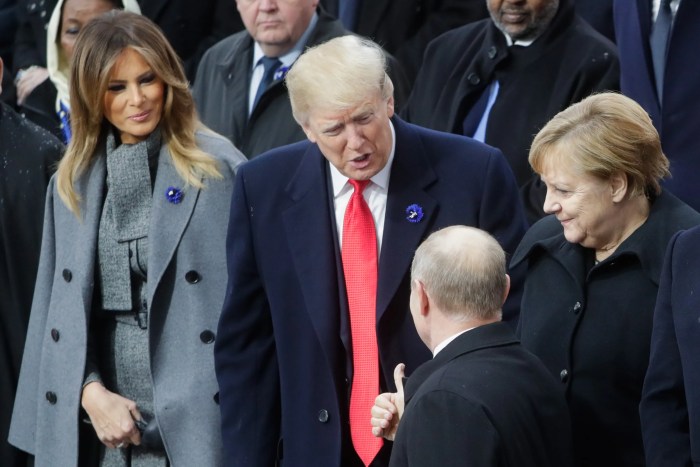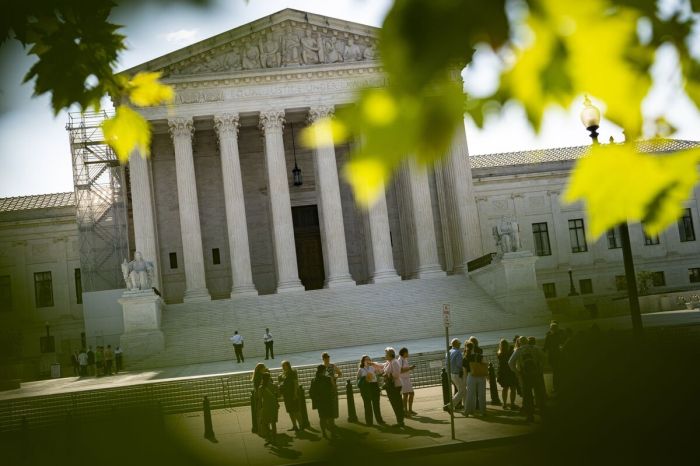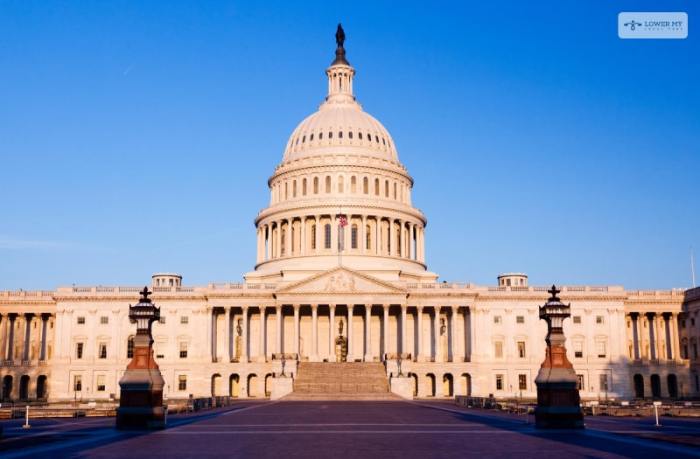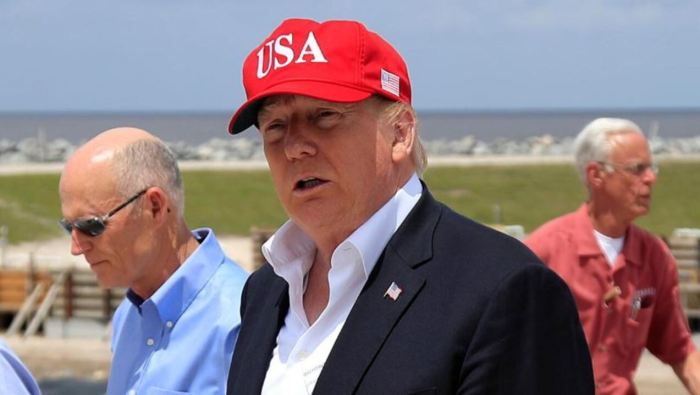
Trump immigration crackdown executive orders significantly reshaped US immigration policy. This in-depth look examines the historical context, the specific actions taken, the impact on various groups, public reactions, comparisons to previous administrations, potential long-term effects, and the legal and constitutional arguments surrounding these controversial orders. Understanding these complex issues is crucial for comprehending the current state of immigration in America.
The orders aimed to curtail immigration through various measures, impacting everything from border security to visa programs. This analysis delves into the details of each order, tracing its path through the legal system and highlighting the diverse perspectives surrounding these policies. It explores the multifaceted consequences for immigrants, the economy, and the broader social landscape.
Historical Context of Immigration in the US
Immigration has profoundly shaped the United States, impacting its demographics, economy, and culture. From the earliest waves of European settlers to the complex contemporary landscape, immigration policy has undergone significant transformations, reflecting shifting societal values and economic realities. This evolution is marked by periods of both inclusivity and exclusion, reflecting the ongoing tension between national interests and humanitarian concerns.A historical understanding of immigration in the US is crucial for comprehending the current debates and policies.
This involves examining the historical context of immigration laws and policies, tracing the evolution of public opinion, and analyzing key events and legislative actions throughout the 20th and 21st centuries.
Early Immigration Policies and Attitudes
Early immigration policies in the US were largely laissez-faire, with minimal regulation. The 19th century witnessed massive waves of European immigrants, primarily from northern and western Europe, driven by economic opportunities and political upheaval. However, these waves also sparked anxieties about cultural assimilation and potential economic competition, contributing to the emergence of nativism and discrimination. These attitudes and policies would shape subsequent immigration legislation.
Key Legislation and Events in the 20th Century
The 20th century saw a significant shift in immigration policies, moving from a largely unrestricted system to one with increasing controls and quotas. The Immigration Act of 1924, for example, implemented national origins quotas, drastically restricting immigration from southern and eastern European countries. This act reflects the rising nativist sentiments of the time, prioritizing the interests of established populations over the needs of newcomers.
Subsequent legislation, like the Immigration and Nationality Act of 1965, attempted to reform the system, abolishing the national origins quotas and introducing preferences based on family reunification and skills. The impact of these policies on the demographics of the US population and its labor market is noteworthy.
Evolution of Public Opinion on Immigration
Public opinion on immigration has fluctuated throughout American history. In periods of economic prosperity, immigration has often been viewed favorably as a source of labor and innovation. Conversely, during economic downturns or periods of social unrest, concerns about the impact of immigration on wages and social cohesion have intensified. These shifts in public sentiment are intricately linked to broader socio-economic factors and reflect the complex interplay between immigration and national identity.
Comparison of Pre-Trump Immigration Policies
| Administration | Key Policy Initiatives | Impact |
|---|---|---|
| Franklin D. Roosevelt | Increased restrictions on immigration, particularly from Asia. | Reduced immigration from certain regions, although overall immigration continued. |
| Harry S. Truman | Immigration policies remained largely focused on quotas and national origins. | Limited immigration from specific regions, reflecting continued nativist concerns. |
| John F. Kennedy | Initiated discussions on immigration reform, but no major legislation passed. | Early efforts to address the shortcomings of existing policies. |
| Lyndon B. Johnson | Landmark Immigration and Nationality Act of 1965. | Shift away from national origins quotas, emphasis on family reunification and skilled workers. |
This table provides a simplified overview of immigration policies from different administrations. Each administration’s approach was influenced by a combination of economic, social, and political factors. The 1965 Act, for instance, marked a significant turning point in US immigration policy, shifting the focus from national origins to family reunification and skills. Further research would provide a deeper analysis of the nuanced impacts of these policies.
Trump’s Executive Orders on Immigration

Donald Trump’s presidency saw a significant shift in immigration policy, largely driven by a series of executive orders. These orders aimed to drastically alter the existing immigration system, often facing immediate and sustained legal challenges. The orders touched upon various aspects of immigration, from border security to visa programs, and their impact was felt across the nation.
Specific Actions Taken by Executive Orders
Trump’s executive orders on immigration sought to implement policies focused on tightening border security, restricting entry for certain groups, and altering visa programs. These actions were often controversial, raising concerns about their legality and their impact on various communities. The orders aimed to address perceived vulnerabilities in the immigration system, including illegal immigration and national security.
Legal Challenges and Court Rulings
Many of Trump’s executive orders faced immediate legal challenges in the courts. Courts scrutinized the orders based on their constitutionality, their alignment with existing laws, and their potential impact on various groups. The outcomes of these legal battles varied, with some orders being temporarily or permanently blocked by the courts. The legal processes surrounding these orders highlighted the complexities of immigration law and the checks and balances within the US legal system.
Key Components and Aims of Each Executive Order
The executive orders often had multiple components and varied aims. They targeted different aspects of immigration, from border security to visa processing and the status of individuals already in the country. Each order had a specific legal basis and intended outcome, although the effectiveness and long-term consequences of these orders were frequently debated.
Table of Trump’s Immigration Executive Orders
| Executive Order | Date | Summary of Actions |
|---|---|---|
| Protecting the Nation from Foreign Terrorist Entry into the United States | January 27, 2017 | Suspended the entry of citizens from several Muslim-majority countries. This order faced immediate legal challenges and was later modified and partially blocked by courts. |
| Executive Order on Enhancing Vetting of Individuals Entering the United States | September 24, 2017 | Further attempted to restrict entry for individuals from specific countries and tightened visa screening procedures. Again, this faced significant legal challenges, leading to modifications and court injunctions. |
| Executive Order on the Construction of a Wall on the Southern Border | January 25, 2019 | This order focused on the construction of a wall along the US-Mexico border, directing the allocation of federal funds. The order faced legal challenges related to funding allocation and environmental concerns. |
Impact on Specific Groups
Trump’s immigration policies, often characterized by strict enforcement measures, had a significant and varied impact on different immigrant groups. These policies, which included executive orders targeting specific nationalities and immigration statuses, created a climate of uncertainty and fear for many. The effects were felt across various demographics, from families seeking reunification to asylum seekers fleeing persecution.The policies aimed at stricter enforcement often resulted in increased detention times for immigrants, separated families, and limitations on legal avenues for entry.
This led to humanitarian crises and legal challenges, prompting significant debate and scrutiny regarding their ethical and practical implications. Furthermore, the economic consequences of these policies are still being analyzed, but early indications suggest potential disruption to labor markets and the overall economy.
Impact on Families
Family separation was a particularly controversial aspect of Trump’s immigration policies. The practice of separating children from their parents at the border, while not explicitly mandated by any executive order, occurred as a result of the enforcement policies. This caused widespread condemnation and fueled legal challenges. The trauma inflicted on children and families was profound, raising significant ethical and legal concerns.
Impact on Asylum Seekers
Trump’s administration implemented stricter criteria for asylum claims, leading to increased denial rates. Asylum seekers, often fleeing violence or persecution in their home countries, faced greater obstacles in obtaining legal status in the US. This policy change had a direct impact on the lives of individuals seeking safety and protection.
Impact on DACA Recipients
The Deferred Action for Childhood Arrivals (DACA) program, which provided temporary legal status to undocumented immigrants who arrived in the US as children, was a significant point of contention. The Trump administration attempted to end the program, leading to widespread protests and legal challenges. The uncertainty surrounding DACA created immense anxiety for the recipients, impacting their educational, employment, and overall well-being.
The program’s future remains uncertain, and the effects of its potential termination continue to ripple through affected communities.
Impact on the Labor Market
The labor market was potentially affected by stricter immigration policies. Reduced immigration could lead to labor shortages in certain sectors, particularly those reliant on low-skilled labor. This could have an impact on the overall economic productivity and wages in these sectors. Conversely, if stricter enforcement reduced unauthorized immigration, it might have the effect of increased wages for workers in the same sector.
Impact on the Economy
The potential economic effects of immigration policies are complex and subject to ongoing debate. Some argue that stricter policies could reduce labor costs for some employers, while others point to the significant contributions immigrants make to the economy, including innovation, entrepreneurship, and filling labor gaps.
Data on Specific Demographics
| Demographic Group | Specific Impact | Potential Consequences |
|---|---|---|
| Families | Increased family separation, detention, and delays in immigration processes. | Increased trauma, legal challenges, and disruptions to family life. |
| Asylum Seekers | Stricter criteria for asylum claims, increased denial rates, and limited access to legal protections. | Increased suffering for those fleeing persecution, potential humanitarian crisis. |
| DACA Recipients | Uncertainty surrounding the program’s future, potential loss of legal status, and disruption to educational and employment opportunities. | Significant anxiety, economic hardship, and potential for legal challenges. |
Public Response and Reactions
Trump’s immigration executive orders sparked a wide range of reactions, from fervent support to passionate opposition. The policies became a flashpoint in the national conversation, deeply dividing the public along political and ideological lines. The debate extended far beyond the halls of government, resonating in communities across the nation.The public response was complex and multifaceted, with different segments of society holding sharply contrasting views.
The political climate surrounding immigration was already charged, and Trump’s policies further inflamed the existing tensions. The media played a crucial role in amplifying and shaping these reactions, influencing public perception and driving the ongoing dialogue.
Political Perspectives
Different political groups and organizations held varying viewpoints on the executive orders. Conservatives generally supported the policies, viewing them as essential for border security and national sovereignty. Conversely, liberals and progressive groups widely opposed the measures, criticizing them as inhumane and discriminatory. The varying interpretations and justifications of the policies led to intense debates and differing levels of public support.
Trump’s immigration crackdown executive orders certainly stirred up a lot of controversy, but the Trump administration’s decision to fire the education research board, as detailed in this article , highlights a broader pattern of prioritizing certain agendas over research-based policy. Ultimately, these actions, like the immigration crackdown, seem to suggest a broader trend of prioritizing specific political viewpoints over objective data and evidence-based decision-making.
Advocacy Group Standpoints
Advocacy groups played a significant role in shaping the public response. Organizations like the American Civil Liberties Union (ACLU) and the National Immigration Law Center vehemently opposed the orders, citing potential violations of civil rights and due process. Conversely, groups like the Federation for American Immigration Reform (FAIR) supported the policies, arguing they were necessary to maintain border security.
These opposing perspectives highlight the deep divisions surrounding immigration issues.
Media Coverage and Public Perception
Media coverage played a significant role in shaping public perception of Trump’s immigration policies. News outlets often presented contrasting viewpoints, amplifying the controversy and fostering a polarized environment. The diverse range of opinions and perspectives were frequently highlighted, but the media’s presentation could sometimes lead to a distorted or simplified understanding of the complexities involved.
Public Demonstrations and Protests
Public demonstrations and protests were common responses to the immigration policies. Millions participated in rallies and marches across the country, expressing their disapproval or support for the orders. These public displays of dissent and affirmation significantly impacted the political discourse surrounding immigration. Examples included large-scale protests against family separation policies and rallies in support of border security measures.
Comparison of Viewpoints
| Viewpoint | Key Arguments | Examples |
|---|---|---|
| Conservative | Stricter border security, national sovereignty, reduced illegal immigration. | Emphasis on maintaining national security, controlling illegal immigration. |
| Liberal/Progressive | Humanitarian concerns, due process, protection of immigrants’ rights. | Concerns about the potential harm to vulnerable populations, emphasis on the importance of fair immigration procedures. |
Comparison with Previous Administrations: Trump Immigration Crackdown Executive Orders
A look back at immigration policies across US history reveals a complex tapestry woven from fluctuating attitudes and shifting priorities. Trump’s approach, while distinct, isn’t entirely unprecedented. Understanding the historical context of previous administrations’ policies allows for a more nuanced comparison and an appreciation for the evolution of immigration laws in the United States.Comparing immigration policies across administrations necessitates a deep dive into the specific legislation, executive orders, and enforcement strategies employed.
Trump’s immigration crackdown executive orders often focused on deportations, and a prime example was the increased focus on deporting individuals from El Salvador. The increased deportations from El Salvador through ICE actions, like those detailed in this article about trump deportation ice el salvador , highlight the complex and often controversial strategies employed during the Trump administration’s immigration policies.
Ultimately, these executive orders aimed to reshape the nation’s immigration landscape, though their effectiveness and impact remain a subject of ongoing debate.
This analysis examines the similarities and differences between Trump’s policies and those of prior administrations, highlighting the historical context of each policy and the evolution of immigration policy in the United States.
Historical Context of Immigration Policies
The United States has a long and often contradictory history regarding immigration. Early immigration policies were largely laissez-faire, allowing relatively unrestricted entry. This changed over time, with periods of strict quotas and stricter enforcement measures, often influenced by economic conditions, social anxieties, and political agendas. The Great Depression, for example, spurred a surge in anti-immigrant sentiment and led to more restrictive policies.
Similarly, periods of war and social upheaval often led to tighter controls on immigration.
Similarities Between Trump’s Policies and Those of Previous Administrations, Trump immigration crackdown executive orders
Several similarities exist between Trump’s immigration policies and those of previous administrations. For instance, a common thread throughout US history is the use of border security measures. Previous administrations, like those of Reagan and Bush, also emphasized border enforcement, though the specific tactics and scope varied. Another recurring theme is the prioritization of national security concerns. Concerns about national security and economic impacts have often influenced immigration policy decisions throughout history.
These concerns have often been used to justify stricter regulations and controls.
Differences Between Trump’s Policies and Those of Previous Administrations
While some similarities exist, Trump’s policies often differed in their scope and approach. The emphasis on separating families, for example, was a notable departure from previous administrations. Furthermore, Trump’s administration frequently used executive orders to implement changes, while other administrations relied more heavily on legislation. The rhetoric surrounding immigration was also more overtly nationalistic and divisive under Trump than in prior administrations.
Evolution of Immigration Policy Across Different Eras
The evolution of US immigration policy reflects the nation’s changing demographics and social attitudes. Early policies were generally permissive, but restrictions emerged throughout the 20th century, particularly in response to economic downturns or social anxieties. The 1965 Immigration and Nationality Act marked a significant shift, moving away from national origin quotas and emphasizing family reunification and skills-based immigration.
Trump’s immigration crackdown executive orders definitely sparked a lot of controversy. It’s fascinating to consider how these actions might relate to other, seemingly disparate events, like the whispers surrounding Elon Musk’s alleged drug use and interactions in the Oval Office, as detailed in this article. Ultimately, these different stories, while seemingly unrelated, highlight the complexities of power dynamics and public perception in today’s political landscape.
The immigration crackdown continues to be a significant topic for debate.
More recently, there’s been a growing debate about border security and the integration of immigrants into American society.
Summary Table of Immigration Policies Across Various Administrations
| Administration | Key Policies/Initiatives | Historical Context |
|---|---|---|
| Trump | Travel bans, increased border enforcement, family separation | Economic anxieties, national security concerns, political rhetoric |
| Obama | Deferred Action for Childhood Arrivals (DACA), increased deportations of criminal aliens | Shifting political landscape, efforts to balance security and humanitarian concerns |
| Bush | Increased border security, anti-terrorism measures | Post-9/11 security concerns, national security |
| Clinton | Immigration Reform and Control Act | Focus on border security and legal immigration |
| Reagan | Increased border enforcement | Economic concerns, growing anti-immigrant sentiment |
Legal and Constitutional Arguments
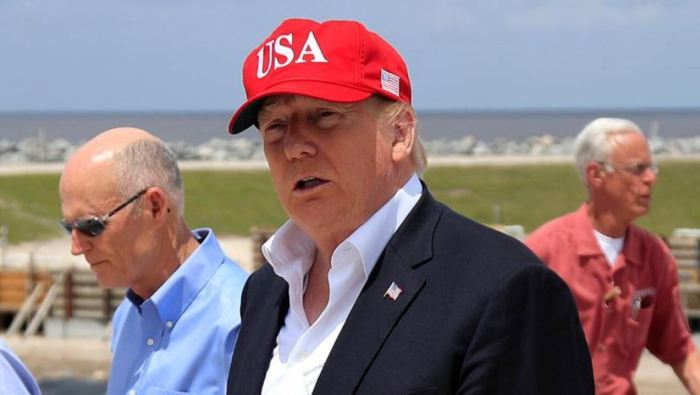
Trump’s immigration executive orders sparked a flurry of legal challenges, raising fundamental questions about the balance of power between the executive and judicial branches, and the scope of presidential authority. These challenges often centered on the constitutionality of the orders, scrutinizing their alignment with established legal precedents and constitutional principles. The judiciary played a crucial role in evaluating the legality of these actions, ultimately shaping the trajectory of immigration policy.
Legal Arguments for and Against the Orders
The legal battles surrounding Trump’s immigration orders involved a complex interplay of arguments for and against the policies. Different legal frameworks were invoked to support and challenge the orders, highlighting the inherent tensions in immigration law and policy.
- Arguments for the Orders: Proponents of the orders often relied on the broad interpretation of the president’s power to regulate immigration, citing the inherent powers of the executive branch and established precedent. They might argue that the orders were necessary to maintain national security, protect borders, and uphold the rule of law. Furthermore, proponents might argue that the orders were within the president’s authority to address perceived national security concerns.
For instance, they might cite the executive’s power to control the entry of individuals into the country and regulate immigration procedures.
- Arguments Against the Orders: Opponents frequently argued that the orders exceeded the president’s authority, infringed on the rights of immigrants, and violated established legal precedents and constitutional principles. Concerns about due process, equal protection, and the separation of powers were often raised. They might point to previous court rulings that limited the executive’s power in immigration matters. Opponents might also argue that the orders disproportionately impacted specific groups, leading to discrimination or other violations of civil rights.
Relevant Legal Precedents
Legal precedents regarding immigration have played a pivotal role in shaping the arguments for and against the orders. Cases that addressed the scope of executive power in immigration, the rights of immigrants, and the role of the judiciary in reviewing executive actions provided a crucial context for the legal challenges.
- Zivotofsky v. Kerry (2015): This case clarified the president’s power to recognize foreign governments and how that might intersect with immigration policy. It was used by some to argue for a broader interpretation of executive power, and by others to argue for a narrower interpretation. The Court’s ruling in this case became a critical reference point for subsequent legal arguments.
- Plyler v. Doe (1982): This case underscored the state’s limited power to discriminate against undocumented immigrants and the importance of due process. It was used by those challenging the orders to highlight the potential for unconstitutional discrimination based on immigration status.
Role of the Judiciary
The judiciary played a vital role in reviewing the constitutionality of the executive orders. Courts exercised their power of judicial review, evaluating whether the orders complied with the Constitution and existing laws.
- Judicial Review: The judiciary’s role in judicial review involves carefully examining executive actions to ensure they align with the Constitution and established laws. This process involves considering the arguments for and against the actions, examining precedents, and applying relevant constitutional principles. The courts weigh the potential impact on individuals and groups, and consider the potential violation of rights or other constitutional protections.
Table: Legal Arguments for and Against Trump’s Executive Orders
| Executive Order | Arguments for | Arguments against |
|---|---|---|
| [Example Order 1] | [Specific legal arguments used to support the order] | [Specific legal arguments used to challenge the order] |
| [Example Order 2] | [Specific legal arguments used to support the order] | [Specific legal arguments used to challenge the order] |
Closure
In conclusion, Trump’s immigration crackdown executive orders left an indelible mark on US immigration policy. The orders sparked intense debate, leading to legal challenges, protests, and significant shifts in public opinion. This examination underscores the complexity of immigration policy, the diverse perspectives involved, and the potential long-term ramifications of such substantial changes. A comprehensive understanding of these policies and their consequences is vital for informed discussion and potential future policy development.


